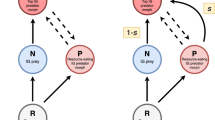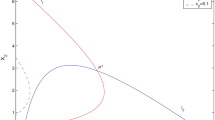Abstract
Intraguild predation, a form of omnivory that can occur in simple food webs when one species preys on and competes for limiting resources with another species, can have either a stabilizing effect (McCann and Hastings in Proc. R. Soc. Lond. B 264:1249–1254, 1997) or a destabilizing effect (Holt and Polis in Am. Nat. 149:745–764, 1997), depending on the assumptions of the system. Another type of behavior that has been observed in simple food web experiments (Murdoch in Ecol. Monogr. 39:335–354, 1969) is prey switching. Prey switching can occur when the predator prefers the most abundant prey. This has also been shown to be capable of having either a stabilizing effect or a destabilizing effect and even possibly lead to predator extinction (VanLeeuwen et al. in Ecology 88:1571–1581, 2007). Therefore, it is clear that incorporating prey switching into an intraguild predation model could lead to unexpected consequences. In this paper, we propose and explore such a model.


Similar content being viewed by others
References
Blasius, B., & Tönjes, R. (2007). Predator–prey oscillations, synchronization and pattern formation in ecological systems. In Analysis and control of complex nonlinear processes in physics, chemistry and biology (pp. 397–427). Singapore: World Scientific.
Cantrell, R. S., & Cosner, C. (2001). On the dynamics of predator–prey models with the Beddington–DeAngelis functional response. J. Math. Anal. Appl., 257, 206–222.
Cantrell, R. S., Cosner, C., & Ruan, S. (2004). Intraspecific interference and consumer-resource dynamics. Discrete Contin. Dyn. Syst., 4B, 527–546.
Hale, J. K. (2009). Ordinary differential equations. Mineola: Dover.
Holt, R. D., & Polis, G. A. (1997). A theoretical framework for intraguild predation. Am. Nat., 149, 745–764.
Hutson, V., & Schmitt, K. (1992). Permanence and the dynamics of biological systems. Math. Biosci., 111, 1–71.
Kuang, Y., & Freedman, H. I. (1987). Uniqueness of limit cycles in Gause-type models of predator–prey systems. Math. Biosci., 88, 67–84.
Liou, L. P., & Cheng, K. S. (1988). Global stability of a predator–prey system. J. Math. Biol., 26, 65–71.
McCann, K., & Hastings, A. (1997). Re-evaluating the omnivory-stability relationship in food webs. Proc. R. Soc. Lond. B, Biol. Sci., 264, 1249–1254.
Murdoch, W. W. (1969). Switching in general predators: experiments on predator specificity and stability of prey populations. Ecol. Monogr., 39, 335–354.
Post, D. M., Conners, M. E., & Goldberg, D. S. (2000). Prey preference by a top predator and the stability of linked food chains. Ecology, 81(1), 8–14.
Tanabe, K., & Namba, T. (2005). Omnivory creates chaos in simple food web models. Ecology, 86(12), 3411–3414.
VanLeeuwen, E., Jansen, V. A. A., & Bright, P. W. (2007). How population dynamics shape the functional response in a one-predator-two-prey system. Ecology, 88(6), 1571–1581.
Acknowledgements
The author gratefully acknowledges support from the Cooperative Institute for Marine and Atmospheric Studies, NOAA Cooperative Agreement NA17RJ1226, and would also like to express his gratitude to David Die (University of Miami) for the opportunity to pursue this research and for his guidance throughout the course of the project and to Chris Cosner (University of Miami) for his helpful suggestions with the analysis.
Author information
Authors and Affiliations
Corresponding author
Appendices
Appendix A: Global Asymptotic Stability of Equilibrium
Consider the predator–prey system

The general assumptions on G(x) and H(x) are:
-
(a)
G∈C 1([0,∞),ℝ), G(0)>0 and there exits K>0 such that G(K)=0 and (x−K)G(x)<0 for x≠K. (Note: In our case, we can let G(x)=r(1−x/K).)
-
(b)
H∈C 1([0,∞),ℝ), H(0)=0 and H′(x)>0 for all x>0. (Note: In our case, we can let H(x)=bx/(a+x).)
-
(c)
There exists a locally stable equilibrium (x ∗,y ∗) such that mH(x ∗)−d=0 and x ∗ G(x ∗)−y ∗ H(x ∗)=0 with 0<x ∗<K, y ∗>0, F′(x)<0 for all x ∗≤x≤K, where \(F(x)=\frac{xG(x)}{H(x)}\).
-
(d)
F(2x ∗−x)≤F(x) for all x satisfying max{0,2x ∗−K}≤x≤x ∗.
-
(e)
\(\frac{d}{H(x)}-m>m-\frac{d}{H(2x^{\ast}-x)}\) for all x satisfying x ∗≤x<min{2x ∗,K}.
Theorem 4
(Liou and Cheng 1988)
Under the assumptions (a)–(e), (x ∗,y ∗) is globally asymptotically stable for system (27) in the interior of the first quadrant.
Appendix B: Uniqueness and Global Asymptotic Stability of Limit Cycle
Consider the system

where G, P, and Q are sufficiently smooth so that existence, uniqueness, and continuability for all positive time are satisfied.
Theorem 5
(Kuang and Freedman 1987)
Suppose in the system (28) that
in 0≤x<x ∗ and x ∗<x≤K. Then the system has exactly one limit cycle which is globally asymptotically stable with respect to the set {(x,y)∣x>0,y>0}∖{(x ∗,y ∗)}.
Rights and permissions
About this article
Cite this article
Zabalo, J. Permanence in an Intraguild Predation Model with Prey Switching. Bull Math Biol 74, 1957–1984 (2012). https://doi.org/10.1007/s11538-012-9740-2
Received:
Accepted:
Published:
Issue Date:
DOI: https://doi.org/10.1007/s11538-012-9740-2




